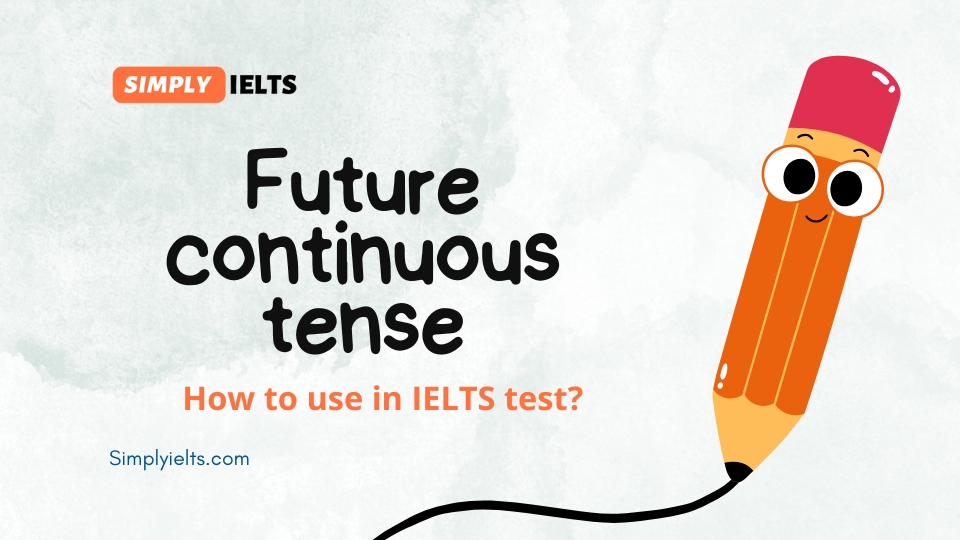In this lesson from the free English grammar course from Simply IELTS, you will learn the structure and formula of the future continuous tense and how to use it in the IELTS exam.

What is the formula of the future continuous tense?
The future continuous tense is used to describe an action or event that will be in progress at a specific time in the future.
It is formed with the auxiliary verb “will” followed by the present participle form of the main verb (the base form of the verb plus -ing).
Here are a few rules for using the future continuous tense:
- Use the auxiliary verb “will” followed by the present participle form of the main verb (the base form plus -ing). For example: “I will be working,” “she will be studying,” “they will be eating.”
- Use the future continuous tense to describe an action or event that will be in progress at a specific time in the future. For example: “I will be cooking dinner at 6:00,” “she will be watching TV at 7:00,” “they will be sleeping at 8:00.”
Examples of the future continuous tense
Here are a few examples of the future continuous tense in action:
- I will be cooking dinner when the phone rings.
- She will be studying for her exams when I see her.
- They will be eating lunch when the storm starts.
In the negative form, the auxiliary verb “will” is followed by “not” and the present participle form of the main verb.
For example:
- I will not be cooking dinner when the phone rings.
- She will not be studying for her exams when I see her.
- They will not be eating lunch when the storm starts.
In the question form, the auxiliary verb “will” is placed before the subject and the present participle form of the main verb is placed after the subject.
For example:
- Will I be cooking dinner when the phone rings?
- Will she be studying for her exams when I see her?
- Will they be eating lunch when the storm starts?
how to use Future continuous tense in IELTS exam?
In the IELTS exam, you may be asked to use the future continuous tense to describe an action or event that will be in progress at a specific time in the future. It is important to use this tense correctly and consistently in your writing and speaking tasks.
Here are a few tips for using the future continuous tense in the IELTS exam:
- Use the correct form of the auxiliary verb “will”: Make sure to use the correct form of “will” based on the subject of the sentence. The correct forms are: “I will,” “you will,” “he/she/it will,” “we will,” “you will,” “they will.”
- Use the present participle form of the main verb: After the auxiliary verb “will,” use the present participle form of the main verb (the base form plus -ing). For example: “I will be working,” “she will be studying,” “they will be eating.”
- Use the future continuous tense to describe an action or event that will be in progress at a specific time in the future: Make sure to specify the time when the action or event will be taking place. For example: “I will be cooking dinner at 6:00,” “she will be watching TV at 7:00,” “they will be sleeping at 8:00.”
- Make sure to use the correct verb tense: It is important to use the future continuous tense consistently in your writing and speaking tasks. Make sure not to mix tenses within a sentence or paragraph.
Examples to use Future continuous tense in IELTS exam
Here are a few examples of how you might use the future continuous tense in the IELTS exam:
Writing Task 1:
“At 7:00 tomorrow evening, I will be cooking dinner while my husband will be watching TV. At 8:00, we will be both relaxing on the couch when the power will go out.”
“Next weekend, I will be visiting my parents in the countryside. On Saturday morning, I will be walking in the woods when I will see a deer. It will be so beautiful and peaceful.”
Writing Task 2:
“Many people believe that technology will be taking over our lives in the future. While it is true that technology has become more prevalent in recent years, I do not think it will be completely taking over. There will still be many people who will be living simple lives and not relying on technology as much as others.”



Responses